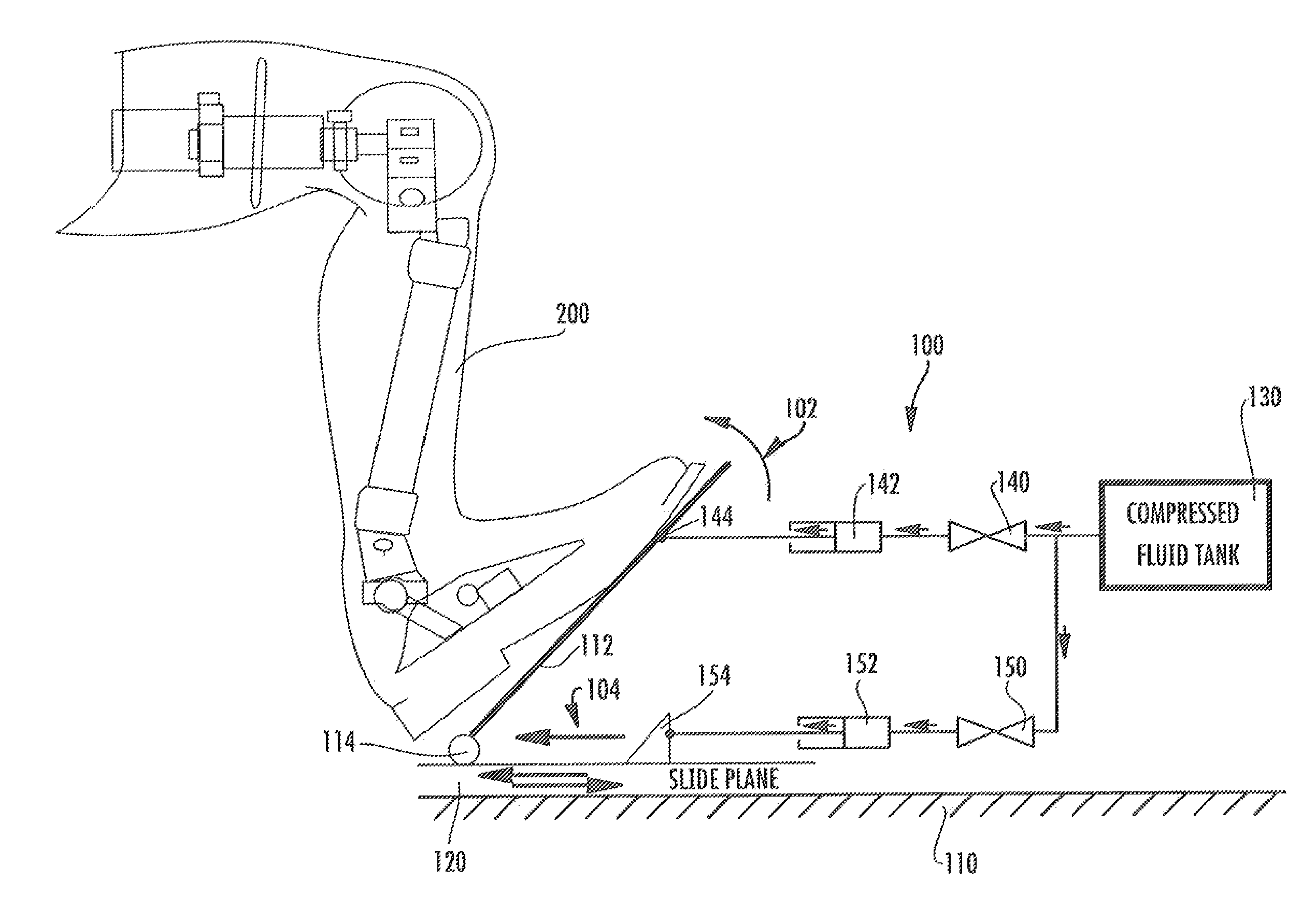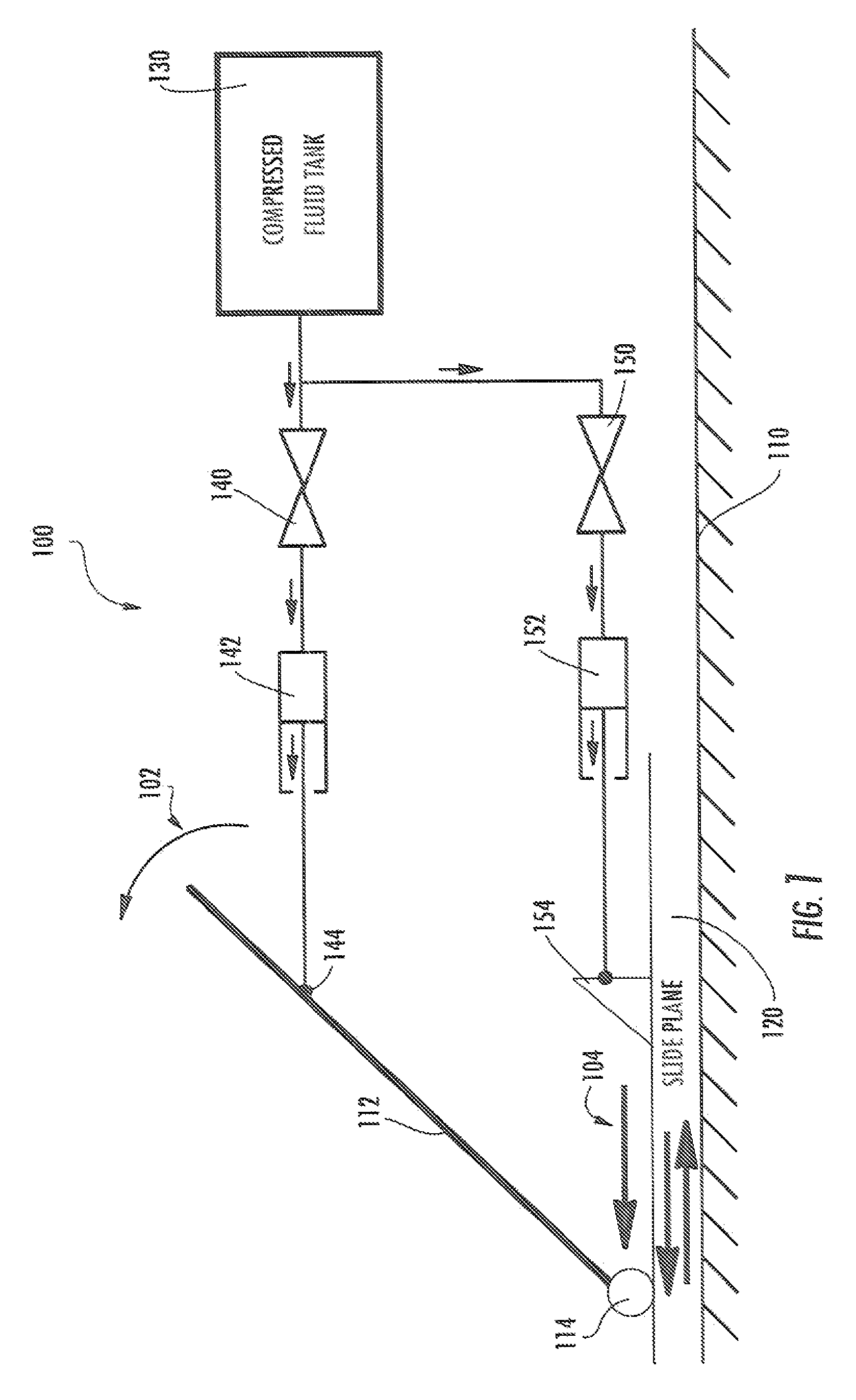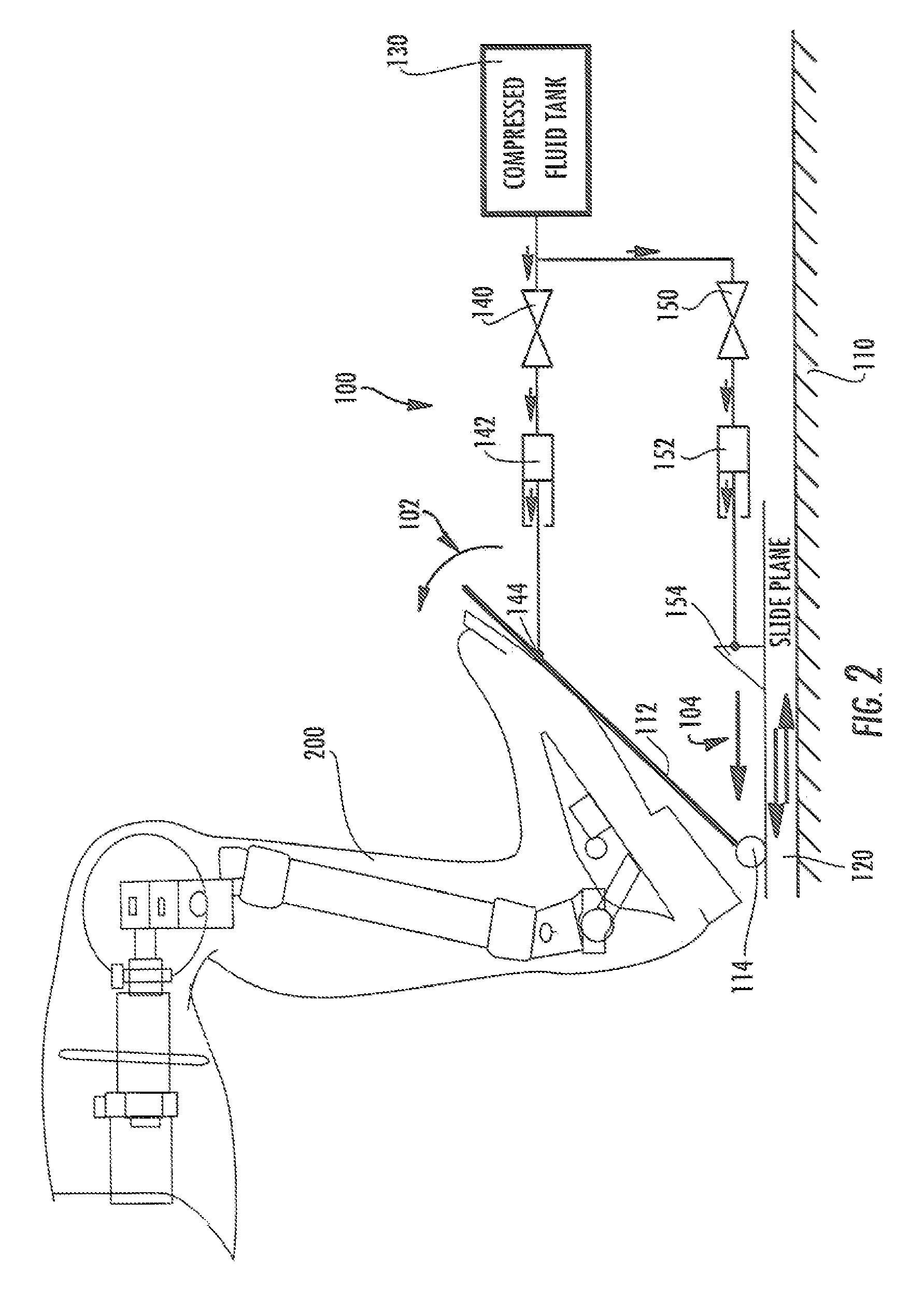[0004]In various exemplary embodiments, the present invention provides a system and a method to enhance HYGE impact sled testing, enabling more accurate measurements of lower leg injury criteria and providing a more accurate restraint system evaluation during a HYGE impact simulator test. The system provides the generation of both rotational and translational footwell intrusion, replicating an actual barrier crash impact test. The rotational and translational footwell intrusion includes foot motion; lower leg motion, including various forces and moments; and knee motion, including interaction with the instrument panel.
[0005]In one exemplary embodiment, the present invention provides a system for impact simulator testing in the footwell region of a vehicle. This system enables more accurate lower leg injury criteria measurements by generating footwell intrusion. The system includes a sled buck; a footrest plant located on the sled buck; a pivot hinge located at the base of the footrest plane and upon which the footrest plant pivots; a slide plane allowing horizontal motion on the floor of the sled buck; a compressed fluid tank; a first timer-released solenoid valve fluidly coupled to the compressed fluid tank; a second timer-released solenoid valve fluidly coupled to the compressed fluid tank; a first piston-cylinder fluidly coupled to the first inner-released solenoid valve; a second piston-cylinder fluidly coupled to the second timer-released solenoid valve; and a translational force block, upon which, when actuated, the second piston-cylinder places a horizontal force, and with which the translational force block is moved horizontally into the footrest plane. A rotational motion is generated by a fluid flow from the compressed fluid tank to the first piston-cylinder, being actuated by the first timer-released solenoid valve and moving horizontally into the footrest plane, thereby creating the rotational motion to the footrest plane. A translational motion is generated by a fluid flow from the compressed fluid tank to the second piston-cylinder, being actuated by the second timer-released solenoid valve and creating the translational motion by moving the translational force block horizontally along the slide plane to the footrest plane. The system is coupled to a hydraulically controlled, gas energized impact simulator sled test. The system also includes an anthropomorphic test device. The anthropomorphic test device is used to measure lower extremity accelerations, forces, and moments during the vehicle crash impact test. The system also includes one or more stops. The one or more stops control the magnitude of the motion simulating footwell intrusion. The magnitude of the rotational motion is stopped at a predetermined level. The magnitude of the translational motion is also stopped at a predetermined level. The compressed fluid tank is pressure adjusted such that a pressure level in the compressed fluid tank is adjusted to mimic the rate of footwell intrusion during an actual barrier crash. The first and second timer-released solenoid valves each are actuated at a unique predetermined time, to better mimic actual footwell intrusion. The first timer-released solenoid valve includes a first orifice that is adjustable, controlling the rate of mass transfer from the compressed fluid tank to the first piston-cylinder. The second timer-released solenoid valve includes a second orifice that is also adjustable, controlling the rate of mass transfer from the compressed fluid tank to the second piston-cylinder.
[0006]In another exemplary embodiment, the present invention provides a method for impact simulator testing in the footwell region of a vehicle. The method enables more accurate lower leg injury criteria measurements by generating footwell intrusion. The method includes providing a sled buck; providing a footrest plane located on the sled buck; providing a pivot hinge located at the base of the footrest plane and upon which the footrest plane pivots; providing a slide plane allowing horizontal motion on the floor of the sled buck; providing a compressed fluid tank; providing a first timer-released solenoid valve fluidly coupled to the compressed fluid tank; providing a second timer-released solenoid valve fluidly coupled to the compressed fluid tank; providing a first piston-cylinder fluidly coupled to the first timer-released solenoid valve; providing a second piston-cylinder fluidly coupled to the second timer-released solenoid valve; and providing a translational force block, upon which, when actuated, the second piston-cylinder places a horizontal force, and with which the translational force block is moved horizontally into the footrest plane. A rotational motion is generated by a fluid flow from the compressed fluid tank to the first piston-cylinder, being actuated by the first timer-released solenoid valve and moving horizontally into the footrest plane, thereby creating the rotational motion to the footrest plane. A translational motion is generated by a fluid flow from the compressed fluid tank to the second piston-cylinder, being actuated by the second timer-released solenoid valve and creating the translational motion by moving the translational force block horizontally along the slide plane to the footrest plane. The method also provides use coupled with a hydraulically controlled, gas energized impact simulator sled test. The method also includes providing an anthropomorphic test device. The anthropomorphic test device is used to measure lower extremity accelerations, forces, and moments during the vehicle crash impact test. The method also includes providing one or more stops. The one or more stops controls the magnitude of the motion simulating footwell intrusion. The magnitude of the rotational motion is stopped at a predetermined level. The magnitude of the translational motion is also stopped at a predetermined level. The compressed fluid tank is pressure adjusted such that a pressure level in the compressed fluid tank is adjusted to mimic the rate of footwell intrusion during an actual barrier crash. The first and second timer-released solenoid valves each are actuated at a unique predetermined time, to better mimic actual footwell intrusion. The method also provides that the first timer-released solenoid valve includes a first orifice that is adjustable, controlling the rate of mass transfer from the compressed fluid tank to the first piston-cylinder. The method also provides that the second timer-released solenoid valve includes a second orifice that is also adjustable, controlling the rate of mass transfer from the compressed fluid tank to the second piston-cylinder.
[0008]Advantageously, the present invention enhances HYGE impact sled testing, enabling more accurate lower leg injury criteria by generating both rotational and translational footwell intrusion. The system and method enable design and impact engineers to define vehicle parameters for optimal crashworthiness, such as footrest location, footrest angle, instrument panel and kneeblocker placement, and maximum allowable footwell intrusion. Also, advantageously, this system and method will provide outputs such as the tibia index for lower leg evaluation and other ATD indicators used in traditional HYGE sled testing.
 Login to View More
Login to View More 


